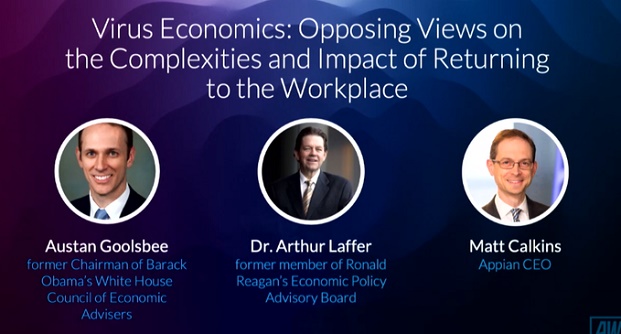Virus Economics: Panelists Weigh Playbook for Safely Getting Back to Work Amid COVID Crisis
Blog: Appian Insight
Economists don’t agree on much, but what the economists on the “Virus Economics” panel did agree on is that we need a playbook for getting safely back to work amid the COVID-19 recession.
It was a lively debate moderated by Appian CEO Matt Calkins, featuring notable big thinkers: Austan Goolsbee, Former Chairman, White House Council of Economic Advisers; and Dr. Arthur B. Laffer, Economist, Member of President Reagan’s Economic Policy Advisory Board.
As a backdrop for the panel, the April jobs report revealed just how much the coronavirus outbreak has pummeled the U.S. economy. There’s the double digit unemployment rate—the highest since the Great Depression. Over 1.3 million confirmed COVID cases. More than 80,000 Coronavirus deaths. And the shedding of profits and more than 20 million jobs.
Turns out a growing number of states are beginning to lift the coronavirus lockdown. But will workers come back as stay-at-home orders are lifted? Will the economy bounce back? Or are we in for a long slog to recovery instead?
CEO Matt Calkins moderates a panel on Virus Economics with leading thinkers Austan Goolsbee and Dr. Arthur Laffer, asking them, “What could we be doing better with regard to the COVID crisis?” #AppianWorld pic.twitter.com/dxuuOvNrhI
— Appian (@Appian) May 12, 2020
“…I always say that the number one rule of virus economics is that the best thing for the economy is anything that slows the rate of spread of the virus,” said Goolsbee. “Over the next several months, we’re going to see some horrible numbers, probably the worst we’ve ever seen by some measures. But it’s not a normal business cycle. If you could wave a magic wand and have a vaccine by next week, we could go right back to doing what we were doing before,” said Goolsby.
Goolsby said that until we find a coronavirus vaccine, we would do best to follow the playbook of countries around the world that have gotten themselves out of lockdown and are back to growing again. This includes a heavy ramp up of testing so that the only workers businesses would have to pull out of commission are people who actually have the disease. People who test negative, said Goolsby, can get back to work.
Laffer agreed with the testing argument but offered a different perspective on the COVID lockdown.
“You know, I think people know very well what’s good for themselves. And anyone 60 (years of age) and over, male, with any type of co-morbidity is obviously at great risk. I think people understand that. And the less lockdown there is, the more you leave it up to individual choice, and I think the better off we’re going to be.”
Laffer called for a tax cut to stimulate the economy. He suggested waiving the payroll tax through the end of the year to jumpstart the economy.
Reducing the cost of employer contribution to social security by 7.65%, said Laffer, would incentivize employers to retain workers and hire new workers and jumpstart the economy to get us back to normal as fast as possible once the lockdown ends.
MyPOV – Kudos to @Appian to not show away from two contrarians on its #Covid19 economic panel Arthur Laffer of @LafferCenter and @Austan_Goolsbee of @ChicagoBooth – Supply vs Demand side economics – great panel #AppianWorld pic.twitter.com/fLo2iLfG2Y
— Holger Mueller (@holgermu) May 12, 2020
It’s impossible to know precisely what the new normal will look like, or just how many jobs might come back as states begin lifting stay-at-home rules. But as long as consumers and workers remain frightened, the economy will likely be slow to bounce back.
“I think we’re both talking about when you get past the peak infection rate for the virus,” said Goolsby. “I really don’t think we should get out of lockdown until we’ve done a big ramp up of testing.” The great danger is that in places where they undo the lockdowns, there’s not enough testing to get people who have the infection out of commission. (So,)You ramp the infection rate back up and then you have to go back into lockdown (again).”
“So, once we’re past the peak of the virus,” said Goolsby, “how do you get the economy growing again? For that, I favor tax cuts or reform like the federal government and the states doing a sales tax holiday. Based on what happened in the Obama and Bush administrations, when you give people tax cuts they don’t spend the money. I think the fundamental problem is there’s no consumer demand. You’ll only benefit from tax cuts when retail comes back,” said Goolsby.
Which brings us to the split in public opinion about lifting the lockdown: CNN recently reported that nearly two-thirds of Americans were concerned about their state opening too early. And, yet, protests have been breaking out across the country for the right to go back to work. The big question is: How do we safely go about getting back to work?
Calkins said the one thing bothering him most is that we don’t seem to know where the finish line is. So, he posed several questions for the panel:
- What is the time that we’re going to go back to work?
- Is it when we’ve got the curve flattened?
- Is it when we’ve got the tests in place so we can test all the time?
- Do we have to wait until we’ve got some kind of a contact tracing technology?
To get the inside scoop on these questions and the rules of virus economics, grab a cup of coffee and tune in to this must-see panel.
Leave a Comment
You must be logged in to post a comment.








